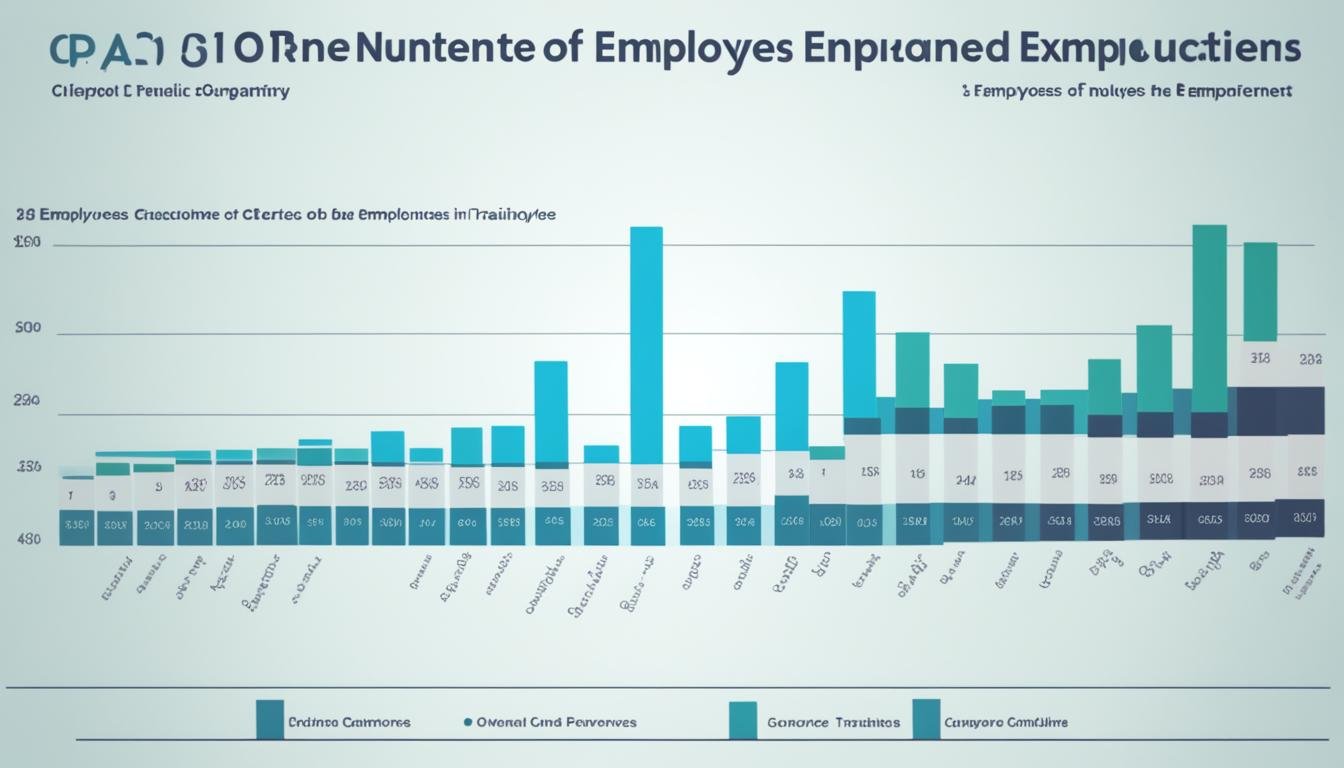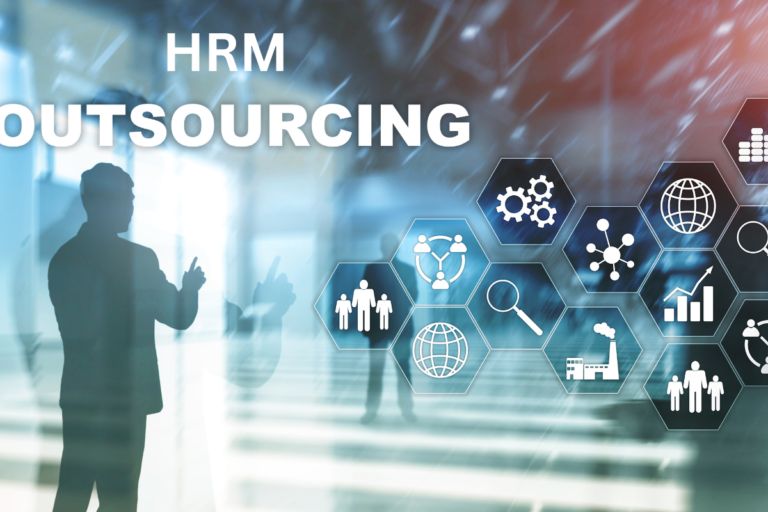A Guide to Human Resources Management Reporting
Human Resources Management Reporting is a crucial aspect of HR strategies. It involves analyzing HR data to gain valuable insights and make data-driven decisions. In this article, we will explore the essentials of Human Resources Management Reporting, including HR analytics, HR data analysis, workforce analytics, HR metrics, HR dashboards, and HR reporting tools. We’ll also discuss the importance of HR data visualization and the role of HR analytics software in elevating HR strategies.
Key Takeaways:
- HR reporting plays a vital role in tracking and monitoring HR functions
- HR metrics and KPIs provide valuable insights for data analysis
- Types of HR reports include turnover and retention reports, recruitment reports, performance management reports, and more
- Effective HR reporting requires HR tools, automation, and data management
- HR data visualization aids in interpreting and communicating HR insights
The Role of Human Resources Management Reporting
Human Resources Management Reporting plays a vital role in HR departments. It involves the collection, analysis, and reporting of HR data to gain insights into various HR functions. HR reporting helps HR professionals track and monitor employee performance, recruitment, turnover, attendance, payroll, and training.
HR analytics and data analysis enable HR teams to identify trends, measure KPIs, and make data-driven decisions to improve HR strategies and drive organizational success. By leveraging HR reporting, HR professionals can effectively manage and optimize HR processes for better workforce management and overall organizational performance.
HR reporting provides valuable information that enables HR professionals to:
- Track and monitor employee performance to identify areas of improvement.
- Identify recruitment trends and strategies for attracting and retaining top talent.
- Analyze turnover rates to identify factors affecting employee retention.
- Monitor attendance patterns and address issues related to absenteeism or tardiness.
- Ensure accurate and timely payroll processing.
- Measure the effectiveness of training programs and identify areas for improvement.
Through data analysis and reporting, HR professionals gain a comprehensive understanding of their organization’s workforce, enabling them to make informed decisions and develop effective HR strategies.
One key aspect of HR reporting is HR data analysis, which involves examining HR data to uncover valuable insights and trends. By analyzing HR data, HR professionals can identify patterns, correlations, and outliers that impact HR functions. This analysis allows HR teams to measure the success of HR initiatives, identify areas for improvement, and make data-driven decisions.
HR analytics software plays a crucial role in HR reporting and data analysis. It provides powerful analytics tools and functionalities that simplify the process of collecting and analyzing HR data. These software solutions enable HR professionals to generate comprehensive HR reports, create interactive dashboards, and visualize HR data through charts and graphs.
Effective HR reporting relies on accurate and relevant data. HR professionals should ensure data integrity, consistency, and quality to facilitate accurate reporting and analysis. By leveraging HR reporting tools and analytics software, HR professionals can transform raw HR data into actionable insights, enabling organizations to make informed decisions and drive continuous improvement.
HR Metrics and KPIs for Data Analysis
HR metrics and KPIs play a crucial role in the effective data analysis of HR reporting. By measuring specific HR indicators, organizations can gain valuable insights into various HR functions and make data-driven decisions to drive success.
HR metrics are quantitative measurements that provide valuable information about specific aspects of the workforce. These metrics help HR professionals understand trends, identify areas of improvement, and track progress. Some common HR metrics include:
- Turnover Rate: Measures the percentage of employees who leave the organization within a specific period.
- Time-to-Hire: Evaluates the average time it takes to hire a new employee from the vacancy announcement to their first day of work.
- Employee Performance: Assesses individual or team performance based on predefined criteria, which may include key performance indicators (KPIs).
- Attendance: Tracks employee attendance patterns, including tardiness and absenteeism.
While HR metrics provide valuable insights, KPIs take them a step further by aligning them with specific business goals and objectives. KPIs are derived from analyzing multiple metrics and enable organizations to measure their progress toward achieving desired outcomes. These indicators help organizations understand whether their HR strategies are effective and drive business success.
For example, if an organization’s goal is to reduce turnover and increase employee retention, the turnover rate can serve as a metric. However, the KPI could be reducing the turnover rate by 10% within a year. By tracking this KPI, HR professionals can evaluate the effectiveness of their strategies and identify areas that require improvement.
Benefits of HR Metrics and KPIs
The use of HR metrics and KPIs in data analysis brings several benefits to organizations:
- Insights into HR Functions: HR metrics provide valuable insights into various HR functions, allowing organizations to identify trends and areas for improvement.
- Data-Driven Decision-Making: By analyzing metrics and KPIs, organizations can make informed decisions based on objective data rather than relying on intuition or guesswork.
- Track Progress: HR metrics and KPIs act as performance indicators, helping organizations track their progress towards HR and business goals.
By utilizing HR metrics and KPIs, organizations can harness the power of data analysis to optimize their HR strategies and achieve greater success.
Now let’s take a look at an example of how HR metrics and KPIs can be presented in a visually engaging table:
| HR Metrics | KPI | Measurement |
|---|---|---|
| Turnover Rate | Reduce turnover rate by 10% within a year | Percentage |
| Time-to-Hire | Average time to hire: 30 days | Days |
| Employee Performance | Improve average performance rating to 4.5 | Rating scale (1-5) |
| Attendance | Reduce absenteeism rate below 2% | Percentage |
Types of HR Reports
HR reports play a crucial role in providing valuable insights into various HR functions. By analyzing HR data and generating reports, HR professionals can make informed decisions and improve HR strategies. Let’s explore some common types of HR reports:
1. Turnover and Retention Report
The turnover and retention report helps organizations understand employee attrition rates, identify trends, and devise strategies to improve employee retention. It provides insights into factors influencing turnover and suggests ways to enhance employee engagement and satisfaction.
2. Employee Recruitment Report
The employee recruitment report focuses on tracking the effectiveness of recruitment strategies, measuring the time-to-hire, and evaluating the quality of new hires. It enables HR professionals to optimize recruitment processes and identify areas for improvement.
3. Performance Management Report
The performance management report assesses employee performance, tracks individual and team goals, and identifies areas for development. It helps HR professionals provide feedback, foster employee growth, and enhance overall organizational performance.
4. Leave and Attendance Report
The leave and attendance report provides insights into employee attendance patterns, tracks leave utilization, and identifies absenteeism trends. It helps HR teams ensure compliance with leave policies and manage workforce productivity effectively.
5. Payroll Report
The payroll report summarizes information related to employee compensation, including salaries, bonuses, and benefits. It ensures accurate and timely processing of payroll, maintains compliance with labor regulations, and aids in budget management.
6. Learning Effectiveness Report
The learning effectiveness report evaluates the impact of training and development programs on employee performance. It assesses the effectiveness of various learning initiatives, measures skill acquisition, and identifies areas where further training may be required.
7. Headcount Report
The headcount report provides a comprehensive view of an organization’s workforce by capturing employee demographics, including the number of employees in different departments or locations. It helps HR professionals plan for workforce expansion or reduction and supports strategic decision-making.
These various HR reports offer HR professionals valuable insights into key aspects of their organization. By leveraging the data and analysis presented in these reports, HR teams can make data-driven decisions, improve HR strategies, and drive organizational success.
Creating Effective HR Reports
Creating effective HR reports is essential for informing data-driven decision-making in human resources. By leveraging HR tools, software, and automation, HR professionals can streamline the process of collecting, analyzing, and reporting HR data, saving time and ensuring accuracy.
Automation plays a crucial role in HR reporting by reducing manual effort and minimizing the risk of errors. With the help of HR software, repetitive tasks such as data collection and analysis can be automated, allowing HR professionals to focus on more strategic initiatives.
HR data management is another key aspect of creating effective HR reports. Organizing and managing large volumes of HR data can be challenging, but with proper data management practices and the right tools, HR professionals can ensure data integrity and accessibility.
When creating HR reports, it’s important to select the right metrics that align with HR goals and objectives. By choosing relevant metrics, HR professionals can provide meaningful insights into key HR functions, track progress, and identify areas for improvement.
Benefits of Creating Effective HR Reports
- Facilitates data-driven decision-making
- Improves transparency and accountability
- Identifies areas for improvement in HR strategies
- Tracks progress towards HR goals and KPIs
By creating effective HR reports, HR professionals can enhance the overall effectiveness of HR strategies and contribute to the success of the organization.
Importance of HR Data Visualization
HR data visualization plays a significant role in HR reporting. It involves presenting HR data in a visual format, such as charts, graphs, and dashboards, to facilitate easy interpretation and analysis.
Data visualization tools enable HR professionals to represent complex data sets in a visually appealing and accessible manner. By transforming raw HR data into graphical representations, HR professionals can effectively communicate important information to stakeholders, making it easier to derive meaningful insights.
Graphical representations of HR data help identify patterns, trends, and outliers, enabling HR professionals to make informed decisions and drive HR strategies. With the help of data visualization tools, HR teams can visually track KPIs, measure performance, and monitor HR metrics in real-time.
Effective HR data visualization enhances data understanding and improves decision-making processes across the organization. Through visually engaging graphics, HR professionals can effectively communicate trends and insights to key stakeholders such as executives, managers, and employees.
Visualizing HR data doesn’t just make it easier to understand; it also enhances the storytelling aspect of HR reporting. By incorporating visually compelling visuals, HR professionals can present data in a more engaging and memorable way. This enhances the overall impact of HR reports and helps stakeholders better comprehend and connect with the insights.
Therefore, HR data visualization is an essential component of HR reporting, enabling HR professionals to transform complex data into actionable insights that drive organizational success.
| Data Visualization Benefits | Explanation |
|---|---|
| Improved Data Understanding | Visual representations make it easier to understand complex HR data. |
| Better Decision-making | Visual insights enable HR professionals to make data-driven decisions. |
| Enhanced Communication | Graphical presentations effectively communicate HR insights to stakeholders. |
| Increased Engagement | Visuals make HR reports more engaging and memorable. |
HR Analytics Software
HR analytics software is a powerful tool that empowers HR professionals to gain deeper insights from HR data. With advanced analytics capabilities, HR teams can analyze HR data to uncover valuable insights that drive informed decision-making. This software not only enables data analysis but also facilitates data visualization and reporting.
By utilizing HR analytics software, HR professionals can track key performance indicators (KPIs) and measure the effectiveness of HR strategies. This data-driven approach helps in identifying areas for improvement and making informed decisions to drive organizational success.
Furthermore, HR analytics software often integrates workforce analytics tools that provide additional functionalities for workforce planning, talent management, and HR strategy development. These tools enable HR professionals to optimize workforce planning by identifying skill gaps, forecasting talent needs, and implementing targeted recruitment strategies.
Additionally, HR analytics software aids in talent management by providing comprehensive insights into employee performance, engagement, and retention. By leveraging this software, HR professionals can develop effective strategies to enhance employee productivity, engagement, and satisfaction.
Moreover, HR analytics software plays a crucial role in HR strategy development by providing essential data for strategic decision-making. HR professionals can analyze workforce demographics, performance trends, and succession planning to align HR strategies with organizational goals.
Overall, HR analytics software is a valuable resource that empowers HR professionals to harness the power of data analysis, visualization, and reporting. By leveraging these tools, HR teams can make better-informed decisions, optimize workforce planning, and drive organizational success.
Benefits of HR Analytics Software:
- Advanced analytics capabilities for in-depth HR data analysis
- Efficient data visualization and reporting functionalities
- Tracking key performance indicators (KPIs) for measuring HR effectiveness
- Integration of workforce analytics tools for strategic workforce planning
- Insights into employee performance, engagement, and retention for talent management
- Support for HR strategy development through data-driven decision-making
Tips for Effective HR Reporting
To ensure effective HR reporting, HR professionals should follow certain best practices. By incorporating these practices, HR reports can provide accurate, relevant, and secure insights to support informed decision-making.
1. Ensure Data Accuracy
Regularly reviewing and validating HR data is essential to ensure data accuracy. By verifying the integrity of the data, HR professionals can trust the information presented in the reports, enabling them to make reliable decisions based on accurate data.
2. Consider Data Relevance
When creating HR reports, it is important to focus on metrics and key performance indicators (KPIs) that align with HR goals and objectives. By selecting the most relevant data points, HR professionals can provide meaningful insights that directly contribute to the success of HR strategies.
3. Prioritize Data Security
Data security is a crucial aspect of HR reporting. HR professionals should prioritize protecting sensitive employee information. Implementing strong data security measures ensures the confidentiality and integrity of HR data, minimizing the risk of unauthorized access or data breaches.
4. Leverage Data Visualization
Data visualization plays a significant role in HR reporting. Utilizing charts, graphs, and dashboards helps present complex HR data in a visually appealing and accessible format. Clear and intuitive data visualization allows stakeholders to quickly grasp insights and trends, facilitating effective decision-making.
5. Embrace Best Practices
Stay up-to-date with industry best practices for HR reporting. Continuously improve reporting processes, optimize data analysis techniques, and explore innovative tools and technologies. By embracing best practices, HR professionals can enhance the effectiveness and efficiency of HR reporting.
“Effective HR reporting requires a combination of accurate data, relevant insights, and robust data security. By adopting best practices and leveraging data visualization, HR professionals can create reports that drive informed decision-making and support organizational success.” – Industry Expert
Following these tips will enable HR professionals to create reports that provide accurate, relevant, and secure insights. By ensuring data accuracy, considering data relevance, prioritizing data security, leveraging data visualization, and embracing best practices, HR reporting can become a powerful tool for driving HR strategies and achieving organizational goals.
HR Reporting Challenges and Solutions
HR reporting presents several challenges that HR professionals must address to ensure the accuracy, quality, and accessibility of HR data. This section will discuss three key challenges in HR reporting: data integration, data quality, and data accessibility. We will also explore potential solutions to overcome these challenges and enhance HR reporting processes.
Data Integration
Data integration involves seamlessly connecting HR systems to ensure the smooth flow of data between different platforms and applications. However, integrating data from diverse sources can be complex and time-consuming. Inconsistent data formats, incompatible systems, and limited technical capabilities can hinder the integration process.
Solution: To overcome data integration challenges, HR professionals can leverage HR analytics software that supports data integration capabilities. By implementing a robust HR analytics platform, organizations can consolidate data from various sources into a centralized database. This provides a unified view of HR data, facilitating comprehensive reporting and analysis.
Data Quality
Data quality is critical for accurate HR reporting and decision-making. Inaccurate, incomplete, and inconsistent data can compromise the reliability and validity of HR reports. Maintaining data quality requires regular data validation, cleansing, and standardization. HR professionals must ensure that data is accurate, up-to-date, and consistent across different HR systems and applications.
Solution: To improve data quality, HR professionals can establish robust data management processes. This includes implementing data validation protocols, conducting regular audits, and enforcing data governance policies. Automation tools can also help identify and rectify data quality issues by flagging inconsistencies and errors.
Data Accessibility
Data accessibility refers to the availability of HR data to relevant stakeholders, such as HR professionals, managers, and executives. Limited access to HR data can hinder decision-making, collaboration, and transparency. Ensuring data accessibility requires the incorporation of user-friendly reporting tools and secure data sharing mechanisms.
Solution: HR professionals can address data accessibility challenges by implementing HR reporting tools that offer a user-friendly interface and self-service capabilities. These tools enable stakeholders to access and analyze HR data independently, without relying heavily on IT or HR teams. Organizations should also establish secure data sharing protocols to ensure the confidentiality and integrity of HR data.
By addressing data integration, data quality, and data accessibility challenges, HR professionals can enhance the effectiveness and value of HR reporting. The following table summarizes the challenges and solutions discussed in this section:
| HR Reporting Challenges | Solutions |
|---|---|
| Data Integration | Implement HR analytics software with data integration capabilities. |
| Data Quality | Establish data management processes, conduct regular audits, and enforce data governance policies. |
| Data Accessibility | Implement user-friendly HR reporting tools and establish secure data sharing protocols. |
Overcoming these challenges will enable HR departments to generate accurate, reliable, and accessible HR reports that support strategic decision-making and drive organizational success. As HR reporting continues to evolve, organizations must remain proactive in addressing these challenges and exploring innovative solutions to optimize their HR reporting processes.
Future Trends in HR Reporting
In the ever-evolving landscape of Human Resources Management Reporting, several future trends are poised to shape the industry. These trends, including predictive analytics, artificial intelligence (AI), and machine learning, hold the promise of revolutionizing how HR professionals leverage data to make strategic decisions. By embracing these technologies, HR departments can gain unprecedented insights into future workforce trends and proactively address challenges.
Predictive Analytics
One of the most significant future trends in HR reporting is the widespread adoption of predictive analytics. Through the use of advanced statistical models and algorithms, HR professionals can analyze historical HR data to make accurate predictions about future outcomes. Predictive analytics empowers HR teams to identify talent gaps, anticipate attrition rates, and forecast training needs, enabling them to develop proactive strategies that mitigate risk and optimize workforce planning.
Artificial Intelligence in Data Analysis
Artificial intelligence (AI) is also poised to play a transformative role in HR reporting. AI-powered analytics tools can automate the data analysis process, handling large and complex datasets with speed and accuracy. By leveraging AI, HR professionals can gain real-time insights into key HR metrics, track employee performance, and monitor engagement levels. AI-driven data analysis not only saves time and resources but also enables HR departments to make data-driven decisions more efficiently.
Machine Learning for Improved HR Strategies
Machine learning algorithms have the potential to revolutionize HR strategies by identifying patterns and correlations within HR data. This technology can uncover previously undiscovered insights, enabling HR teams to refine talent acquisition strategies, enhance employee engagement initiatives, and optimize performance management processes. As machine learning continues to evolve, it will unlock possibilities for HR reporting that were previously unimaginable.
“The integration of predictive analytics, artificial intelligence, and machine learning in HR reporting will allow organizations to gain a competitive edge by making data-driven decisions that drive increased employee productivity and satisfaction.” – Jessica Patel, HR Analytics Expert
The future of HR reporting is bright, with predictive analytics, artificial intelligence, and machine learning at the forefront of innovation. These technologies will empower HR professionals to make more accurate predictions, automate data analysis, and uncover valuable insights that drive strategic decision-making. By embracing these future trends, HR departments can better leverage HR data and ultimately optimize organizational success.
Conclusion
Human Resources Management Reporting is a critical component of effective HR strategies. Through the utilization of HR analytics, HR professionals can analyze HR data and extract valuable insights to make well-informed decisions. HR reports play a pivotal role in tracking and monitoring various HR functions, including recruitment, performance, attendance, and payroll. By incorporating HR analytics software and data visualization tools, HR professionals can streamline the HR reporting process, leading to enhanced organizational success.
Staying updated with the latest trends and incorporating best practices is crucial for HR professionals to ensure effective HR reporting. By embracing HR analytics and leveraging data visualization tools, HR professionals can present HR data in a visually appealing and easily interpretable format. This enables them to identify patterns and trends, ultimately leading to meaningful insights and proactive decision-making.
In this ever-evolving field of human resources, it is essential for HR professionals to adapt and evolve. By embracing HR analytics, HR reporting, and HR data analysis, professionals can maximize their HR strategies’ potential and drive their organizations towards achieving their goals. By continuously refining their skills, staying updated with industry trends, and leveraging innovative HR tools, HR professionals can propel their organizations forward and excel in their roles.







